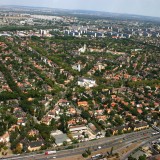Distirct XIX, Budapest, Hungary
The garden suburb of Wekerletelep was built between 1908 and 1921 on the outskirts of Budapest to accommodate its growing population, laid out along garden city lines in a square plot with a radiating axial layout plan.
In particular there was large scale immigration from the countryside, and the need for housing for these rural workers may have influenced the choice of building a garden settlement. It was built on land purchased by the government on the outskirts of the city. Reminiscent of Hampstead Garden Suburb, Wekerle included a central square with schools, churches, cinema and police station, creating a self-contained community on the edge of the city. Its houses were designed in a mix of arts and crafts and local vernacular style, with gardens, allotments and tree lined streets and squares. Now no longer on the outskirts of the city, the area retains its feel of a village within a city. It was made a national monument in 2011.
Settlement/development timeline
- Devised in 1908
- Constructed between 1909 and 1921
Original master planner and any other critical master planning, design and architects:
Devised by József Fleischl
Main architect: Karoly Kos (main square & several buildings)
Other architects included Lajos Schodits, Béla Eberling, Dezső Zrumeczky, Gyula Wälder and Dénes Györgyi.
Architectural Style/qualities:
- Local vernacular
- Hungarian Secessionist
Housing/other built form densities
1,007 houses; 4,412 apartments
Governance arrangements
Part of City of Budapest (XIX District, Kispest)
Other notable features that reflect Garden City Principles
- Priority was given to government employees among rent applicants, but the estate, being very popular from the beginning already had 25% of its population from the privately employed, mostly workers of nearby factories.
According to the government's concept (most of the renters would be young, often unmarried clerks and low-level government officials), the majority of the houses include small apartments. The most common arrangement is the 45 m2 two-room apartment in 12-apartment complexes. 3-room 59 m2 apartments are also common. Larger units are rare, there are a few larger apartments in the 2-storey buildings on the central square. There's a handful of distinct, almost villa-like housings with larger apartments, referred popularly as "headmaster's house" or "doctor's apartment", the name probably stemming from their originally intended function. - The main, central square was very important for the concept of "building for the community", thus planning of the main square was a separate project, won by Károly Kós one of the star architects of the period. He designed the arrangement with the radial street layout and also one of the trademark wooden gates (the eastern one).
- Fifty thousand trees were planted during the construction, mainly along the spacious avenues. The estate had its own gardening service, who not only took care of the many plants, flowers and trees of the community spaces, but also helped renters to groom their own gardens as well. Four fruit trees were planted for each apartment (altogether 16.000), and thanks to the favorable sandy soil and to the care of the new dwellers, they were hugely successful.
- Indeed, in 1917 the redcurrant harvest was so rich that residents could earn almost four times their yearly rent just by selling their fruits.
Find out more
http://wekerletelep.hu/introduction/
Wekerlei Tarsaskör Egyesület
Kós Károly tér 10.
1192 Budapest
Ungarn
Tel.: +36 1 280 0114
Kontaktperson
Agnes Pap
Mészáros L. u. 38.
1192 Budapest
Ungarn
Tel.: +36 20 563 1948

